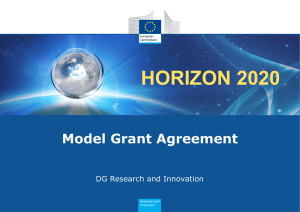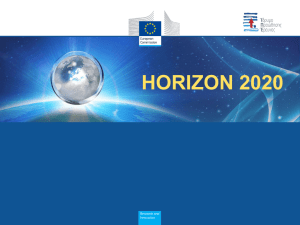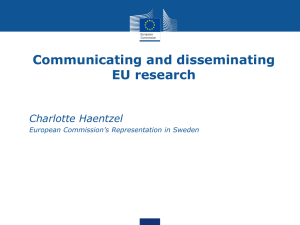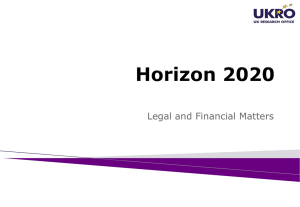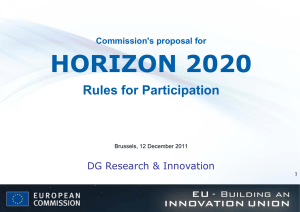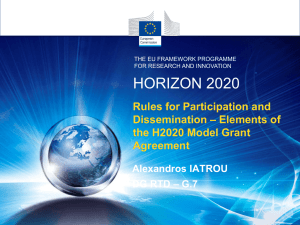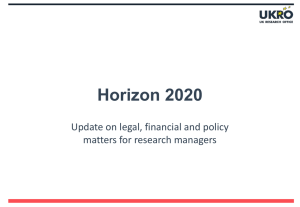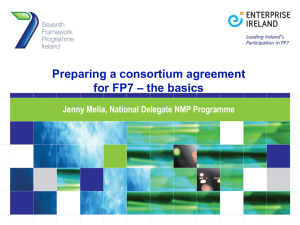Objectives Horizon 2020 model Grant Agreement
advertisement
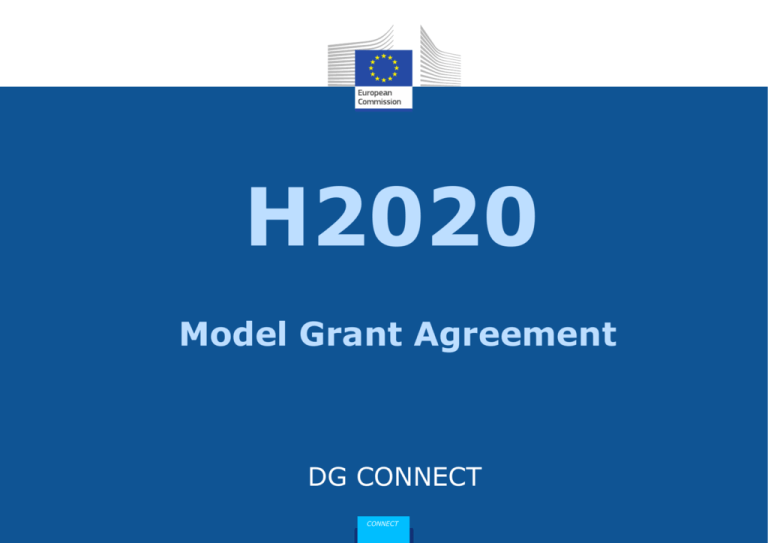
H2020 Model Grant Agreement DG CONNECT CONNECT Horizon 2020 model Grant Agreement: Simplification • Provisions • Wording Coherence • Within H2020 and with other EU programmes Objectives Flexibility • To accommodate particularities • Usual cost accounting practices Continuity • Where possible and adequate Horizon 2020 model Grant Agreement: Accommodating specificities ERC MGA MarieSklodowska Curie MGA General Model Grant Agreement Co-fund MGA SME instrument MGA Grant Agreement Some novelties Global architecture common with the other EU programmes; with all the possibilities offered by the new FR Terminology: terms and meanings defined in the Financial Regulation except for those terms specific to H2020 On-line explanations for each part of the grant ("annotated GA") Simplified wording revised by a specialised service of the Commission Electronic communication for the management of the Grant Agreement: Electronic signature • Of the Grant Agreement • Of the Amendments • Financial Statements and Technical reports Communication between the Commission and the beneficiaries • Through the Participant Portal • Electronic-only submission of reports as a general rule Horizon 2020 model Grant Agreement: A single document with all provisions Core text General conditions FP7 Specific provisions Annexes III Chapter 1: General • Single article: subject of the agreement Chapter 2: Action • Action, duration and budget Chapter 3: Grant • Amount, rates, eligible costs Chapter 4: Rights and obligations • • • • To implement the action: resources, in-kind contributions, subcontracts Grant administration: reporting, payments, audits Background and results: access rights, protection of results, exploitation, dissemination Others: gender equality, ethics, confidentiality Chapter 5: Division of roles • Roles and responsibilities, internal arrangements Chapter 6: Rejection, reduction, penalties, termination, etc • Rejection, reduction, recovery and penalties • Suspension and termination of the action Chapter 7: Final provisions • Accession, entry into force, amendments, applicable law Horizon 2020 model Grant Agreement: Annexes to the grant Annex I: Description of the action Annex II: Estimated budget Annex III:Accession Forms Annex IV: Financial statements Annex V: Certificate on the financial statements Annex VI: Certificate on the methodology FORMS OF FUNDING What will remain from Grant Agreements as the main funding stream. Reimbursement of actual costs as the main funding method. What will be Specific provisions for new forms of funding targeting innovation: e.g. pre-commercial procurement, procurement of innovative solutions Possibility of output-based grants (lump-sums per project). Enhanced use of other lump-sums, flat rates and unit costs. A SINGLE FUNDING RATE Maximum reimbursement rates Research and technological development activities (*) Network of excellence 50% 75% (**) Collaborative project(****) 50% 75% (**) Coordination and support action Demonstration activities Other activities 100% 50% 100% 100% (***) (*) Research and technological development includes scientific coordination. (**) For beneficiaries that are non-profit public bodies, secondary and higher education establishments, research organisations and SMEs (***) The reimbursement of indirect eligible costs, in the case of coordination and support actions, may reach a maximum 7% of the direct eligible costs, excluding the direct eligible costs for subcontracting and the costs of resources made available by third parties which are not used on the premises of the beneficiary. (****) Including research for the benefit of specific groups (in particular SMEs) One project = One rate Same rate for all beneficiaries and all activities in the grant. The applicable rate will be defined in the Work Programme: Up to 100 % of the eligible costs; but limited to a maximum of 70 % for innovation projects (exception for non-profit organisations - maximum of 100%). COST REIMBURSEMENT PERSONNEL COSTS Wider acceptance of average personnel costs (now under unit costs) Broadening the basic conditions for acceptance of average personnel cost accounting practices (including cost-centre approaches). Acceptance of supplementary payments for non-profit organisations of up to 8000 Euro/year/person Simplifying participation for SMEs Providing in the Rules for a unit cost system for SME owners and physical persons without a salary. Less requirements for time records No time records for researchers working exclusively on the project. Simplified provisions on annual productive hours Two options: 1720 hours or usual cost accounting practice subject to a minimum threshold. SINGLE INDIRECT COST MODEL Unique method: 25 % flat-rate Aiming at simplifying project management and reducing recurrent errors. Combined with practical guidance for large research infrastructures on how costs can be accepted as direct costs. 60% ? 20% ? Single model: 25 % Flat Rate Real ? Simplified? New funding model: what impact on the EU contribution? An example In FP7, around 90 % of the Universities and more than a half of the Research Organisations apply the 60 % flat-rate for indirect costs. For all these participants the impact on the EU contribution of the H2020 funding model will be favourable: Flat-rate (60 %) 100 / 25 Funding Direct costs Indirect costs Total costs % EU contribution EU contribution 100 60 160 75% € 120 Direct costs Indirect costs Total costs 100 25 125 % EU EU contribution contribution 100% € 125 CONTROLS AND AUDITS Financial viability Most beneficiaries exempt from detailed analysis; only systematic check for coordinators when requested EU funding for the project is ≥ 500 k€ Certificate on financial statements Only for final payments when total EU contribution claimed by the beneficiary on the basis of actual costs ≥ 325.000 € Optional Certificates on average personnel costs (now under unit costs) NB: The provisions are in Horizon 2020 Regulation! Ex-post audits Audits of the Commission limited to two years after the payment of the balance Audit strategy focused on risk and fraud prevention Extrapolation New Financial Regulation will apply; detailed provisions in the MGA Guarantee Fund Continuity of the system under procedures similar to those applied in FP7 Thank you for your attention! DG CONNECT CONNECT
